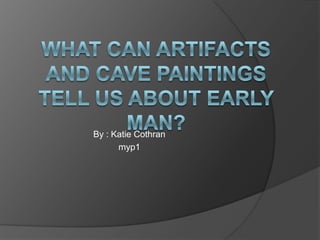
What early cave paintings reveal about prehistoric man
- 1. What can artifacts and cave paintings tell us about early man? By : Katie Cothran myp1
- 2. Prehistoric artifacts Hand axes: By 1.7 to 1.6 million years ago homo erectus hand increased there ability to make tools, and were using stone tools which had sharper and straighter edges. This was new way of tool making acheulian and it was named after a saint in south west France were this artifact was found but originated in East Africa . Hand axes were used for : chopping wood, digging roots and bulbs, killing animals and cracking nuts and bones.
- 3. Hand axes Were used by cave men for hunting and were very resourceful. They also came in handy for sharpening weapons.
- 4. The ancient Peruvian necklace The ancient Peruvian necklace: In 6,000,000 D.C quartz crystals seemed to be used for retrial burials. In 3,000,500 B.C they found the first man made glass in Egypt. In 3,000,300 there was evidence that quartz crystal was mimed in Egypt. They found a quartz beaded necklace on a Peruvian mummy. This is extraordinary because they didn’t know what tools they would use to make these tiny beads. This artifact was found in Egypt ( the necklace) and the mummy was found in Peru. Also they used the crystal for strength and when they crystal is under pressure it can produce energy, we know that right know but they don’t know if they knew it back then. The power of crystals was believed to be derived and when they found crystals in caves they thought it was connected to the earth.
- 5. Quartz crystals This ancient necklace was found on a mummy recently in Peru and is known to be a more than a thousand years old. Description: clear white, it looks a lot like plastic and is made of thousands of quartz crystals!
- 6. cave paintings Cave paintings: known as the prehistoric sistine chapel lascaux caves were found In South West France, and were found by teenagers in 1940, and they are thought to be from at least 15,000,000 years ago. This is a map where the Lascaux cave is located in France
- 7. lascaux cave paintings This is a picture of men hunting Deer and Baby Deer, and the Deer’s are running at the men but they keep shooting their arrows, and the Deer are getting injured!
- 8. The lascaux cave paintings This is a very common photo found in the lascaux cave. Description: large cow, and a half of a cow’s head. They look like they have puncture
- 9. Tools made for the cave paintings and resources that created the colours. The earliest and most basic images are finger drawings in soft clay on the rock surface where the artist following the example of claw marks made by animals. Then came engraving, by far the commonest method, using flakes of sharp flint and in some cases stone picks. Different types of rocks, and rock formations, were used to give variety, add colour and produce depth. Clay engraving on the cave floors has usually been obliterated by the feet of modern visitors, but some good examples survive. Finally, and most impressively, we get painting. The first colours were red, iron oxide and black . White from kaolin or mica was used occasionally. At Lascaux they have found pestles and mortars in which colours were mixed, together with no less than 158 different mineral fragments from which the mixtures were made. T Shells of barnacles were used as containers. One master employed a human skull. Cave water and the calcium it contained were used as mixers, and vegetable and animal oils as binders. The artists had primitive crayons and they applied the paint with brush tools, though none has survived. All kinds of devices and implements were used to aid art. Important lines were preceded by dots, which were then Joined up. Sometimes paint was sprayed using their mouths. Stencils were used. Blow pipes made from bird bones served as tubes for applying paint.
- 10. The difficulties the painters faced , creating the cave paintings. Difficulties: there were loads of difficulties such as, they couldn’t just go to the store and buy paint they had to create paint from scratch and tools they would use to draw the paintings. Also they had to find lots of natural resources which of course is very hard to do. And it probably took “ages” for them to create them.
- 11. What might be the significance of these paintings for early humans? It tells us how are ancestors live. Also it helps us explore the difference between now and back then. It tells us how there family structure was like and how they live and what they ate! It let’s us look into how we have changes so much through out these thousands of years.